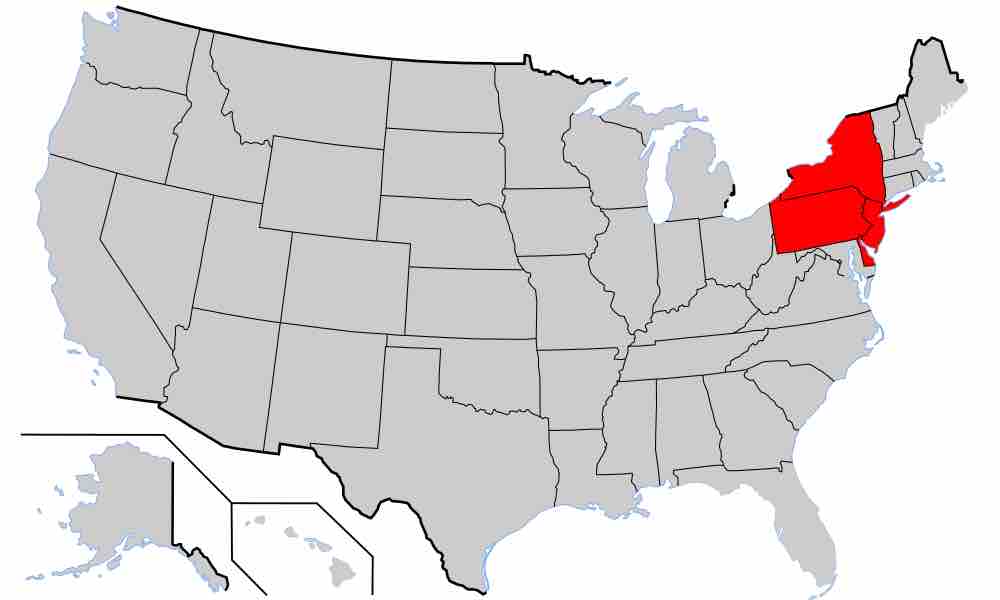Introduction: The Middle Colonies
The Middle Colonies consisted of the middle region of the Thirteen Colonies of the British Empire in North America. In 1776, during the American Revolution, the Middle Colonies became independent of Britain as the states of New Jersey, Pennsylvania, New York, and Delaware.

Middle Colonies
The Middle Colonies was comprised of Delaware, New Jersey, New York, Pennsylvania.
Establishing the Colonies
New York
Henry Hudson explored the Middle Colonies on a journey into the Hudson River and Delaware Bay in 1609. The Dutch soon claimed the land, and although the Swedes and the Dutch fought over the land in the 1630s, the Dutch ultimately claimed the land as New Netherland. In the 1660s, the English largely conquered this land, renaming the area New York after the Duke of York, James II. The colony's land was periodically granted to various proprietors and split into the Province of New York and the Province of Pennsylvania.
New Jersey
James II later granted the land between the Hudson River and the Delaware River to two friends who had been loyal to him through the English Civil War. This land grant became the Province of New Jersey. In 1665, the Concession and Agreement was written to entice settlers to New Jersey. This document provided for religious freedom, no taxes without assembly approval, and a governor appointed by the proprietors. When one of the proprietors sold his share to the Quakers, this sale divided New Jersey into East Jersey and West Jersey; however, the border between the two remained disputed. From 1701 to 1765, colonists skirmished in the New York-New Jersey Line War over disputed colonial boundaries. In 1702, Queen Anne united West and East Jersey into one Royal Colony—the Province of New Jersey.
Pennsylvania
King Charles II granted the land for the Pennsylvania Colony to William Penn in 1681 as payment for a debt the crown owed his family. Penn wrote the Frame of Government of Pennsylvania, which called for religious tolerance towards many, including local American Indians and the Religious Society of Friends. As a proprietary colony, Penn governed Pennsylvania, yet its citizens were still subject to the English crown and laws. In 1704, Dutch land given to Penn by the Duke of York was separated and once again became part of the Delaware Colony. From 1692 to 1694, the revolution in England deprived Penn of the governance of his colony. The Pennsylvania Assembly took this opportunity to request expanded power for elected officials. Upon visiting the colony in 1669 and 1701, Penn eventually agreed to allow their Charter of Privileges to be added to the constitution.
Delaware
Delaware changed hands between the Dutch and Swedes between 1631 and 1655. The Dutch maintained control of Delaware until 1664, when it was renamed New Castle after the Duke of York. A deputy of the Duke governed Delaware from 1664 to 1682. When William Penn received his land grant of Pennsylvania in 1681, he received the Delaware area from the Duke of York and dubbed it "The Three Lower Counties on the Delaware River." In 1701, after he had troubles governing the ethnically diverse Delaware territory, Penn agreed to allow it a separate colonial assembly.
Economy of the Middle Colonies
The Middle Colonies tended to mix aspects of the New England and Southern Colonies. Landholdings were generally farms of 40 to 160 acres, owned by the family that worked them. In New York's Hudson Valley, however, the Dutch poltroons operated very large landed estates and rented land to tenant farmers. Indentured servitude was especially common in the Pennsylvania, New Jersey, and New York in the 18th century, though fewer worked in agriculture.
Unlike New England, the Middle Colonies had richer, less rocky soil, allowing the area to become a major exporter of wheat and other grains. Its large exports led to its constituent colonies becoming known as the Bread Basket Colonies. Pennsylvania became a leading exporter of wheat, corn, rye, hemp, and flax, making it the leading food producer in North America from 1725 to 1840. Broad navigable rivers like the Susquehanna, the Delaware, and the Hudson attracted diverse business, and New York and Philadelphia became important ports.
Abundant forests attracted the lumbering and shipbuilding industries to the Middle Colonies. In Pennsylvania, sawmills and gristmills were abundant, and the textile industry grew quickly. The colony also became a major producer of pig iron and its products, including the Pennsylvania long rifle and the Conestoga wagon. Other important industries included printing, publishing, and the related industry of papermaking. While the Middle Colonies had far more industry than the Southern Colonies, they still did not rival the industry of New England.
Demographics of the Middle Colonies
The Middle Colonies were the most ethnically diverse British colonies in North America, with settlers coming from all parts of Europe—many as indentured servants. They were also the most religiously diverse part of the British Empire, with a high degree of tolerance. The Penn family was Quaker, and the Pennsylvania colony became a favorite destination for that group as well as German Lutherans, German Reformed, and numerous small sects such as Mennonites, Amish, and Moravians, as well as Scotch Irish Presbyterians. The Dutch Reformed were strong in upstate New York and New Jersey, and Congregationalists were important in Long Island.